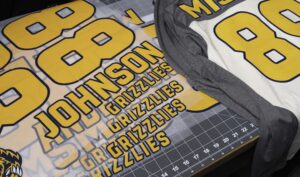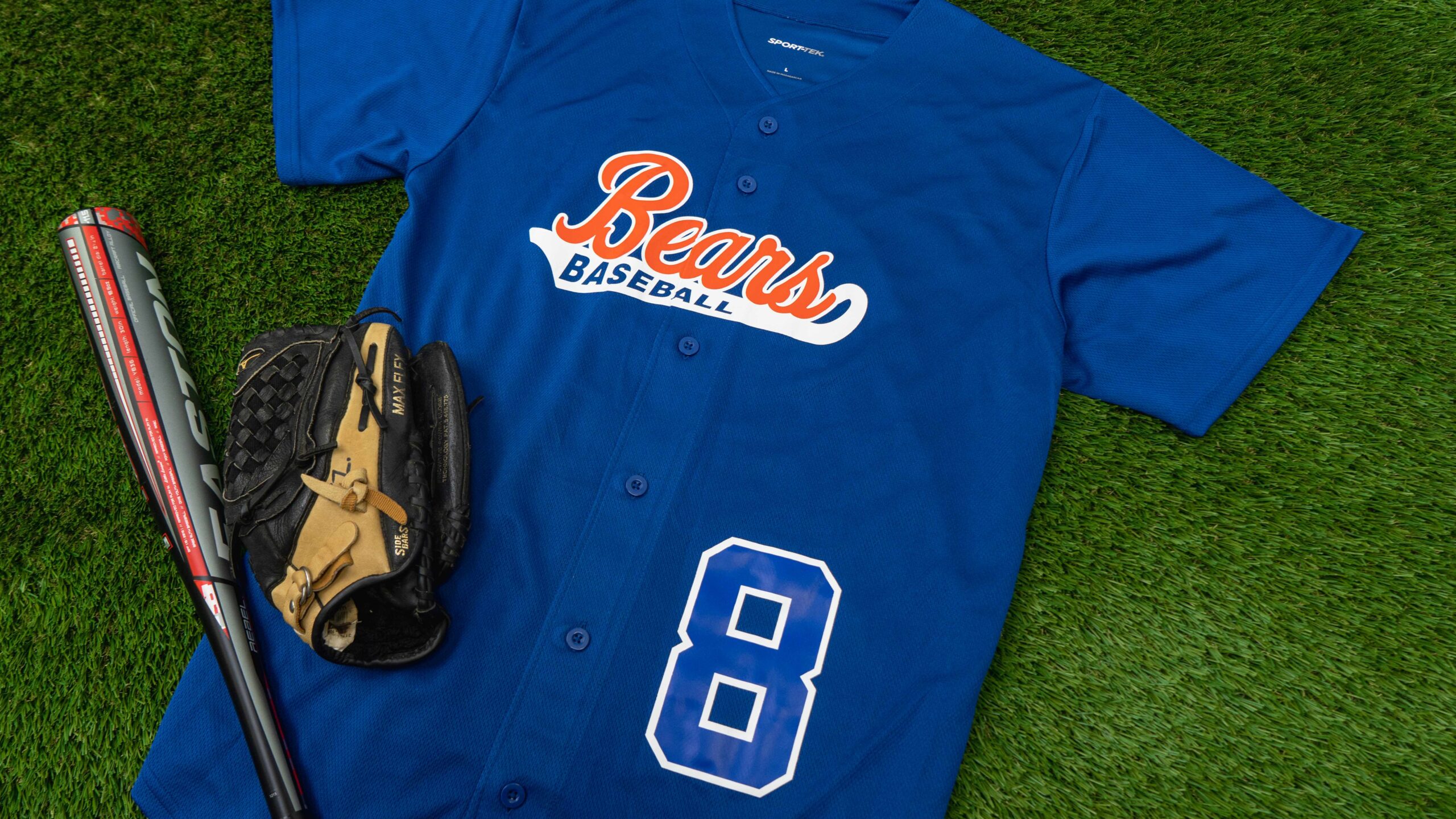Bringing custom decorated team apparel to life with DTF and other heat printing methods
There’s something special about pulling on a jersey with your name and number for the first time. Whether it’s a young athlete getting their first team uniform, a company softball team suiting up for some friendly competition or a pro athlete stepping onto the field, those numbers and letters create a sense of identity and belonging.
Heat printing has revolutionized the way teams big and small get personalized uniforms quickly and affordably. From classic block numbers to modern metallic, reflective or multi-color designs, today’s technology makes anything possible. The same techniques that bring instant customization to stadiums and high-profile events, like the NFL Draft, are also helping local sporting goods stores and print shops fulfill orders with ease.
So, how do the pros do it? What are the best methods and materials for different fabrics and team styles? Whether you’re gearing up for a championship season or outfitting a weekend league, here’s a behind-the-scenes look at the latest trends and tools in team jersey printing.
Heat Transfers: A Winning Strategy for Team Jerseys
Screen printing has long been the go-to method for decorating team jerseys, especially for bulk orders where the same logo is printed over and over. It’s efficient, cost-effective and delivers durable results that stand up to the wear and tear of a season. However, when it comes to individual personalization—adding player names and numbers—heat transfers are the industry standard. Whether it’s a little league team, a local rec squad or a pro-level event, heat printing offers the flexibility to customize each jersey on demand.
In fact, when it comes to this kind of customization, one of the biggest challenges in uniform printing isn’t the application—it’s the design process. Creating artwork, inputting player names and numbers and ensuring accuracy can be tedious and time-consuming. You may therefore want to consider using an online designer, such as the STAHLS’ Team Builder platform (part of the STAHLS’ family of companies, including STAHLS’ Transfer Express) to streamline the process.
The key to an online design platform, like STAHLS’ Team Builder, is the fact it allows you to upload a team roster and instantly generate ready-to-print designs for each jersey. This is true whether you’re ordering DTF transfers or screen-printed transfers. No more typing in names one at a time or having to worry about misprints; an online design platform Team Builder automates the process, ensuring consistency and efficiency.
With the right software, you can personalize jerseys in just a few clicks. The software allows you to input a roster and apply personalized text across all jerseys instantly. Additionally, you can see live mockups and pricing, which means you get to see your designs in real time and obtain accurate quotes before ordering.
If you have custom logos, you can also upload them and incorporate any team branding you’d like for a polished, professional look.
So far, so good. Bear in mind, though, that in addition to having to decide whether to go with an online designer and service provider or not, you also need to select a decorating method. Among the more well-established options out there are direct-to-film (DTF), screen-printing and hybrid transfers, with pricing varying by transfer. Beyond that, another couple of options to consider include pre-cut and pre-spaced numbers.

Pre-spaced numbers and names make the heat-pressing process that much easier and faster. Photo courtesy of STAHLS’
Traditionally, pre-cut numbers and letters, also known as die-cut numbers, have allowed for effective on-demand personalization. Granted, having to manually align each individual character can be time-consuming. Nonetheless, pre-cut numbers, such as STAHLS’ Thermo-FILM numbers, have long been the fastest, easiest and most cost-effective way to add numbers to jerseys. Specifically, with a heat press, it’s possible to print as many as 15 numbered team uniforms in 30 minutes or less. Pre-cuts are available in multiple styles, sizes and colors, including two-color options, offering a word of possibilities.
Making things even easier are Pre-Spaced Numbers and Pre-Spaced Text, which arrive on a single carrier sheet, eliminating alignment issues and reducing application time. While slightly more expensive, they save labor costs in the long run. If you want to save even more money and bring it all in house, you can always cut your names and numbers yourself using a vinyl cutter and any number of different CAD-CUT materials as well.
Heat transfer vinyl (HTV) is another popular method for customizing small batches of uniforms, especially when dealing with one-off orders or teams with frequently changing rosters. It is especially effective for stretchable, moisture-wicking sportswear, as newer vinyl formulations provide flexibility and durability.
It’s for this reason that many professional and college teams, not to mention large leagues, will have a cutter and a heat press in their locker rooms to make sure they always have the right jersey for a player who needs to take the field. Note: decorators typically apply heat-pressed numbers separately when using sublimation for team jerseys.
Emerging Trends in Team Uniform Printing
As team sports gear evolves, decorators must stay ahead of emerging trends. Here are some of the top innovations shaping uniform customization in 2025:
1) Performance-Driven Materials
Athletes expect uniforms that enhance performance through lightweight, breathable, moisture-wicking fabrics. However, traditional printing methods, like screen printing, can sometimes interfere with breathability. Recommended printing solutions include:
- Stretchable heat transfer vinyl for maximum flexibility
- DTF transfers that bond well with polyester without restricting movement
- Silicone heat transfers to prevent dye migration on synthetic fabrics
2) Hybrid Decoration Techniques
Many decorators are now layering multiple heat-applied techniques to create more dynamic and premium designs. Popular hybrid approaches include:
- Dimensional transfers: Raised silicone or soft foam transfers add a tactile effect.
- Overlaying transfers: Combining full-color transfers with heat transfer vinyl for depth and texture.
- Patches & emblems: Adding embroidered or silicone patches for a high-end look
3) On-Demand Customization & Digital Ordering
Speed is key in today’s market. Many decorators are using online design tools to streamline the uniform ordering process. Some design platforms allow customers to enter team rosters, select fonts and colors, and preview designs before placing orders. Essential tools for on-demand printing include:
- Online team building design software to help generate mockups
- Pre-stocked blank uniforms to ensure rapid turnarounds
- Auto-open heat presses to facilitate faster production times
Winning Business in Team Sports Printing
Expanding into the team uniform market requires a strategic approach. With this in mind, here are some steps to help you establish a successful operation:
- Invest in the right equipment: Whether you’re using a screen-printing press, a heat press, or a DTF printer, having the right equipment ensures efficiency and quality.
- Offer personalization services: Providing heat-applied names and numbers is essential for attracting team orders.
- Stay up to date with trends: As sportswear fabrics evolve, choose decoration techniques that maintain breathability, stretch and durability.
- Simplify ordering for customers: Offering an online design and ordering tool can make the process seamless for coaches, league organizers and team managers.
- Optimize your workflow: Using pre-spaced numbers and letters, along with an efficient heat press setup, can significantly cut down production time.
The Right Decoration Method for Every Job
The team uniform market offers a wealth of opportunities for decorators, but success depends on selecting the right printing method. Remember, you will probably have to use a combination of different methods depending on the sport, the type of jersey and the desired finished look.
By combining heat-printing methods strategically, decorators can create professional, durable and visually appealing team uniforms while maximizing efficiency.
Karin Bellinghausen is vice-president of communications for GroupeSTAHL, parent company for acclaimed heat-press manufacturer STAHLS’ Hotronix and custom DTF and heat-transfer materials supplier STAHLS’ Transfer Express. In addition to its online design software, the company also result debuted the comprehensive e-commerce and online business service, STAHLS’ Fulfill Engine.





